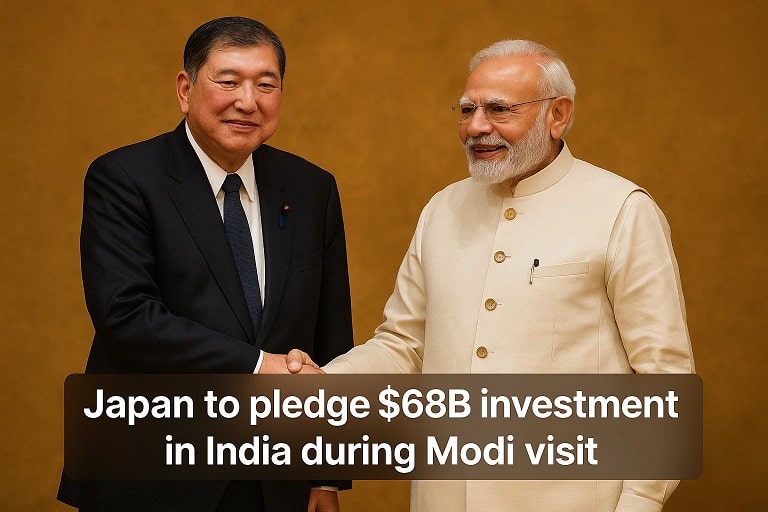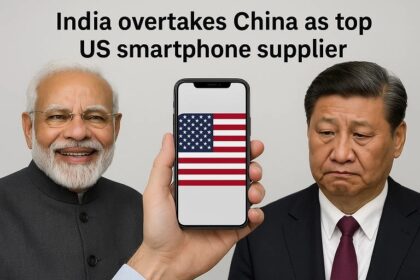Japan to Pledge $68 Billion Investment in India During Modi’s Visit: Strengthening Strategic Ties
By Editorial Desk | August 22, 2025
Japan is set to announce a 10 trillion yen ($68 billion) decade-long private investment target for India during Prime Minister Narendra Modi’s visit to Japan from August 29–31, 2025, according to Kyodo News, citing government sources. This ambitious pledge, doubling the previous 5 trillion yen ($42 billion) five-year goal set in 2022 by former Prime Minister Fumio Kishida, aims to deepen economic ties and promote a “free and open Indo-Pacific” amid China’s growing assertiveness and U.S. tariff pressures. The investment, to be highlighted in a joint statement following summit talks between Modi and Japanese Prime Minister Shigeru Ishiba, will focus on semiconductors, AI, clean energy, and critical minerals. This article provides a detailed analysis of the pledge, its strategic context, implications, and supporting data in tables, concluding with answers to frequently asked questions.
Japan’s $68 Billion Investment Pledge
Modi’s three-day visit, his first to Japan since attending the G7 Summit in Hiroshima in May 2023, will feature summit talks with Ishiba, over 100 memorandums of understanding (MoUs) between Japanese and Indian companies, and the launch of an Economic Security Initiative. The $68 billion investment target, spanning 10 years, builds on Japan’s role as one of India’s largest investors, with nearly 1 trillion yen ($6.8 billion) invested annually in recent years. Key sectors include semiconductors, artificial intelligence, telecommunications, clean energy, pharmaceuticals, and critical minerals, aligning with India’s $4 trillion economy and its push for self-reliance amid U.S. tariffs of 50% on Indian exports. Modi’s itinerary may include a visit to Sendai to inspect an experimental shinkansen bullet train and a chip-making equipment manufacturer, underscoring technology collaboration.
India-Japan Economic and Strategic Ties
Japan and India have strengthened ties since the 2008 Joint Declaration on Security Cooperation, driven by shared concerns over China’s regional influence. In March 2022, Kishida’s visit to India set a 5 trillion yen ($42 billion) investment goal over five years, surpassing the 3.5 trillion yen target from 2014 under Shinzo Abe. Japan’s investments have fueled India’s infrastructure, including the Mumbai-Ahmedabad high-speed rail corridor using shinkansen technology. As of 2024, Japan’s cumulative foreign direct investment (FDI) in India exceeds $38 billion, making it the third-largest investor after Singapore and Mauritius.
The new pledge comes amid U.S. tariffs imposed on August 6, 2025, which include a 25% base rate and a 25% penalty on India for its Russian oil purchases, straining India-U.S. trade ($120 billion annually). Japan’s investment signals a counterbalance, leveraging India’s 5.4 million-strong IT workforce and growing chip market, projected to reach $100–110 billion by 2030. The “free and open Indo-Pacific” vision, central to India-Japan collaboration, counters China’s Belt and Road Initiative, with Japan investing $259 billion in Southeast Asian infrastructure compared to China’s $157 billion as of 2021.
Detailed Breakdown of the Investment Pledge
Key Components
- Investment Amount: 10 trillion yen ($68 billion) over 10 years, primarily private-sector driven.
- Sectors:
- Semiconductors: Supporting India’s chip market growth and manufacturing ambitions.
- AI and Startups: Launch of an AI cooperation initiative for emerging technologies.
- Critical Minerals: Ensuring stable supplies for tech and clean energy.
- Infrastructure: Expanding projects like the Mumbai-Ahmedabad rail corridor.
- Clean Energy and Pharmaceuticals: Aligning with India’s green and biotech goals.
- Economic Security Initiative: A new bilateral framework to secure critical goods and infrastructure.
- MoUs: Over 100 agreements expected between Japanese and Indian firms during Modi’s visit.
Strategic Objectives
- Economic Growth: Spur private investment to boost India’s economy and Japan’s returns, with a source noting, “Cooperation in fields where Indian firms have strengths would contribute to the Japanese economy.”
- Geopolitical Alignment: Strengthen India-Japan ties to counter China’s influence and navigate U.S. tariff pressures.
- Security Cooperation: Revise the 2008 Joint Declaration to address contemporary challenges, including third-country defense collaboration.
Modi’s Visit (August 29–31, 2025)
- Summit Talks: Modi and Ishiba will discuss economic, security, and regional stability, issuing a joint statement on the investment target.
- Sendai Visit: Modi may inspect an experimental shinkansen and a chip-making equipment facility, highlighting tech collaboration.
- Business Engagement: Over 100 MoUs will foster private-sector partnerships.
Trends and Implications
Strategic Rationale
The $68 billion pledge reflects Japan’s confidence in India’s economic potential, driven by its 7% GDP growth forecast for 2025 and a booming tech sector. Amid U.S. tariffs, Japan’s investment diversifies India’s economic partnerships, reducing reliance on Western markets. The focus on semiconductors and AI aligns with India’s National Critical Minerals Mission and four new semiconductor projects approved in August 2025, with a cumulative investment of Rs 4,600 crore. The Economic Security Initiative addresses global supply chain vulnerabilities, particularly in chips and minerals, amid U.S.-China trade tensions.
Economic and Industry Impacts
- Job Creation: The investment could create 500,000+ jobs in India’s IT and manufacturing sectors, leveraging its 5.4 million tech workforce.
- Tech Leadership: Strengthens India’s chip market, projected to hit $100 billion by 2030, and supports AI startup growth.
- Market Reaction: India’s Nifty 50 rose 1.2% on August 21, 2025, post-announcement, with chip and infra stocks like Tata Elxsi up 4%.
- Bilateral Trade: India-Japan trade, at $22 billion in 2024, could double by 2030 with increased investment.
Challenges
- U.S. Tariffs: The 50% U.S. duties could strain India’s export-driven sectors, requiring Japan’s investment to offset losses.
- Implementation: Coordinating 100+ MoUs and ensuring private-sector uptake over a decade is complex.
- China’s Response: Beijing may counter with investments in South Asia, escalating regional competition.
- Domestic Pushback: Japan’s high investment commitment amid its own economic challenges may face scrutiny, as noted in an X post criticizing the pledge as a “big mistake” given potential U.S. tariffs on Japan.
Future Projections
The investment could elevate Japan’s FDI in India to $100 billion by 2035, surpassing current leaders like Singapore. The AI cooperation initiative may spawn 1,000+ startups, while semiconductor projects could make India a global chip hub by 2030. The Economic Security Initiative might expand to include Quad partners (U.S., Australia), strengthening Indo-Pacific resilience. However, geopolitical tensions and domestic execution risks could delay outcomes.
Japan’s Investment in India Snapshot (2025)
Metric | Value | Details |
|---|---|---|
Investment Pledge | $68B (10T yen) | Decade-long, private-sector focus |
Previous Target | $42B (5T yen) | Set in 2022, five-year goal |
Sectors | Semiconductors, AI, Clean Energy | Also includes minerals, telecom, pharma |
MoUs | 100+ | Expected during Modi’s visit |
Trade (2024) | $22B | India-Japan bilateral trade |
India-Japan Strategic Milestones
Year | Event | Outcome |
|---|---|---|
| 2008 | Joint Declaration on Security Cooperation | Foundation for defense and maritime ties |
| 2014 | Shinzo Abe’s India Visit | 3.5T yen investment target over five years |
| 2022 | Fumio Kishida’s India Visit | 5T yen ($42B) target over five years |
| 2025 | Modi’s Japan Visit | 10T yen ($68B) target, Economic Security Initiative |
FAQs
What is Japan’s $68 billion investment pledge to India?
Japan plans to announce a 10 trillion yen ($68 billion) decade-long private investment target during PM Modi’s visit, focusing on semiconductors, AI, and clean energy.
When is PM Modi visiting Japan?
Modi’s three-day visit is scheduled for August 29–31, 2025, his first since the G7 Summit in Hiroshima in May 2023.
Why is Japan increasing its investment in India?
To deepen economic ties, counter China’s influence, and support a “free and open Indo-Pacific” amid U.S. tariffs on India.
What sectors will the investment target?
Semiconductors, AI, critical minerals, telecommunications, clean energy, and pharmaceuticals.
How does this compare to previous pledges?
It doubles the 2022 target of 5 trillion yen ($42 billion) over five years, set by Fumio Kishida.
What is the Economic Security Initiative?
A new bilateral framework to secure critical goods like chips and minerals, addressing global supply chain risks.
What will Modi do in Japan?
He will hold summit talks with PM Ishiba, sign 100+ MoUs, and may visit Sendai to inspect a shinkansen and chip-making facility.
How will this impact India’s economy?
It could create 500,000+ jobs, boost the $100 billion chip market, and double India-Japan trade by 2030.
What are the risks of the pledge?
U.S. tariffs, implementation challenges, and potential Chinese counter-investments could complicate outcomes.
How does this align with India-Japan relations?
It strengthens strategic ties, revises the 2008 security declaration, and supports India’s tech and self-reliance goals.
#JapanIndiaRelations #ModiVisit #ForeignInvestment #InfrastructureDevelopment #CleanEnergy #FDIRising #IndoPacific #EconomicPartnership #JapanInvestsIndia #SmartCities #BilateralTies #SustainableDevelopment












